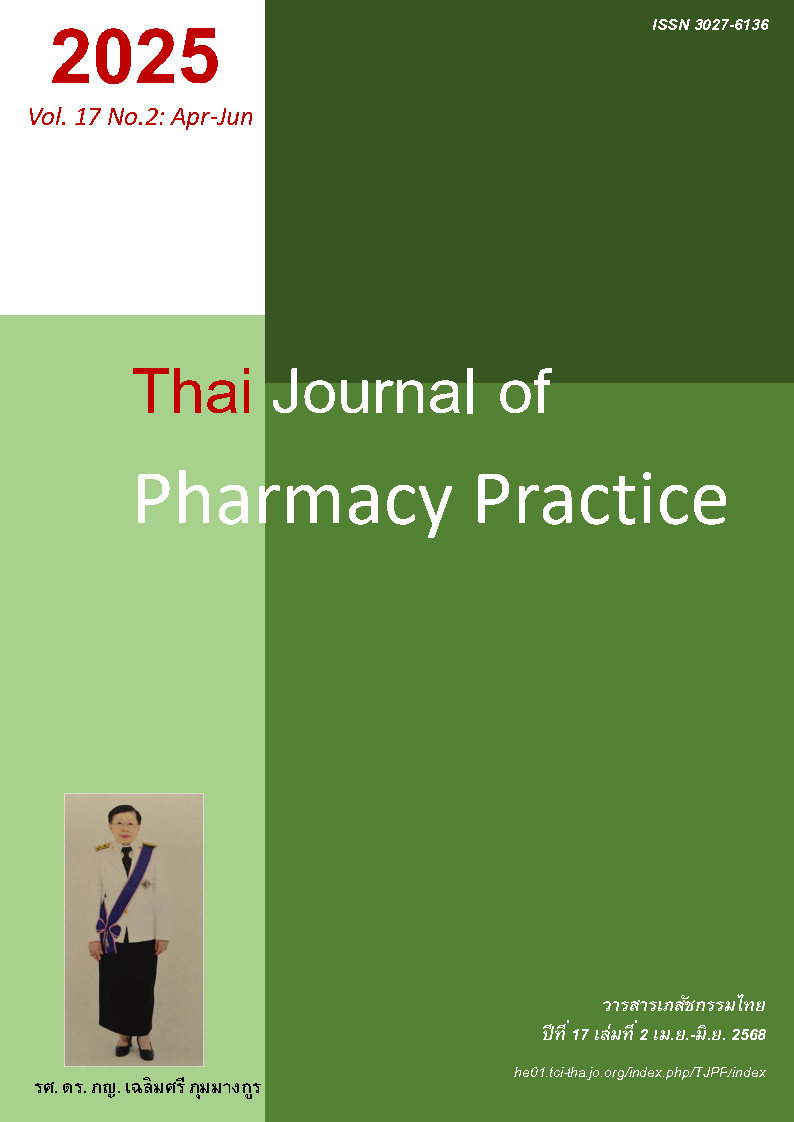การพัฒนาเครื่องมือบ่งชี้ทางคลินิกในการเกิดภาวะเม็ดเลือดขาวชนิดนิวโทรฟิลต่ำ ในผู้ป่วยมะเร็งปอดที่ได้รับยาเคมีบำบัด ณ โรงพยาบาลมหาราชนครเชียงใหม่
Main Article Content
บทคัดย่อ
วัตถุประสงค์: เพื่อพัฒนาเครื่องมือบ่งชี้ทางคลินิกในการเกิดภาวะเม็ดเลือดขาวชนิดนิวโทรฟิลต่ำจากยาเคมีบำบัดในผู้ป่วยมะเร็งปอด วิธีการ: การศึกษารูปแบบ retrospective cohort study เก็บข้อมูลย้อนหลังจากเวชระเบียนและเวชระเบียนอิเล็กทรอนิกส์ของผู้ป่วยโรคมะเร็งปอด ณ โรงพยาบาลมหาราชนครเชียงใหม่ คณะแพทยศาสตร์ มหาวิทยาลัยเชียงใหม่ ที่เข้ารับการรักษาในระหว่างวันที่ 1 มกราคม พ.ศ. 2559 ถึง วันที่ 31 ตุลาคม พ.ศ. 2565 กลุ่มตัวอย่างแบ่งเป็น 2 กลุ่ม ได้แก่ กลุ่มที่เกิดภาวะเม็ดเลือดขาวชนิดนิวโทรฟิลต่ำและกลุ่มที่ไม่เกิดภาวะเม็ดเลือดขาวชนิดนิวโทรฟิลต่ำ การศึกษาวิเคราะห์ความสัมพันธ์ของปัจจัยต่าง ๆ กับภาวะเม็ดเลือดขาวชนิดนิวโทรฟิลต่ำ จากนั้นนำผลที่ได้ไปพัฒนาเครื่องบ่งชี้ทางคลินิกโดยการถ่วงน้ำหนักคะแนนด้วยสถิติ mixed effect model การศึกษาหาจุดตัดของคะแนนเสี่ยงด้วยวิธีการโค้ง receiver operating characteristic (ROC) และนำเสนอความสามารถของคะแนนเสี่ยงในการทำนายภาวะเม็ดเลือดขาวชนิดนิวโทรฟิลต่ำ ผลการวิจัย: กลุ่มตัวอย่าง 799 รายที่เข้ารับการรักษาทั้งหมด 2,617 ครั้ง เกิดภาวะเม็ดขาวชนิดนิวโทรฟิลต่ำ 20 ครั้ง และไม่เกิดภาวะดังกล่าว 2,597 ครั้ง ปัจจัยที่สัมพันธ์กับการเกิดภาวะเม็ดเลือดขาวชนิดนิวโทรฟิลต่ำอย่างมีนัยสำคัญทางสถิติ ได้แก่ ปริมาณเม็ดเลือดขาวชนิดนิวโทรฟิลก่อนการเข้ารับยาเคมีบำบัดที่น้อยกว่า 3,000 cell/mm3 การได้รับยาเคมีบำบัดกลุ่ม platinums กลุ่ม vinca alkaloids และกลุ่ม topoisomerase II inhibitors เมื่อนำปัจจัยที่พบมาพัฒนาเกณฑ์คะแนนเสี่ยง ได้คะแนนเสี่ยงที่มีช่วงคะแนน 0 - 6.5 คะแนน พื้นที่ใต้โค้ง ROC เท่ากับร้อยละ 83.63 จุดตัดคะแนนที่ได้มีดังนี้ ความเสี่ยงต่ำ (< 2.0 คะแนน) ความเสี่ยงปานกลาง (2.0 - 2.5 คะแนน) และความเสี่ยงสูง (> 2.5 คะแนน) ได้ค่า LHR+ (95%CI) เท่ากับ 0.37 (0.19 - 0.73), 2.54 (1.55 - 4.14), และ 12.99 (5.79 - 29.11) ตามลำดับ สรุป: เครื่องมือบ่งชี้ทางคลินิกที่พัฒนาขึ้นเพื่อทำนายการเกิดภาวะเม็ดเลือดขาวชนิดนิวโทรฟิลต่ำจากยาเคมีบำบัดในผู้ป่วยมะเร็งปอด มีความถูกต้องสูงและมีความสามารถในการทำนายดี อย่างไรก็ตามควรมีการทดสอบยืนยันก่อนนำไปใช้ในสถานพยาบาลอื่น ๆ ที่มีบริบทแตกต่างออกไป
Article Details

This work is licensed under a Creative Commons Attribution-NonCommercial-NoDerivatives 4.0 International License.
ผลการวิจัยและความคิดเห็นที่ปรากฏในบทความถือเป็นความคิดเห็นและอยู่ในความรับผิดชอบของผู้นิพนธ์ มิใช่ความเห็นหรือความรับผิดชอบของกองบรรณาธิการ หรือคณะเภสัชศาสตร์ มหาวิทยาลัยสงขลานครินทร์ ทั้งนี้ไม่รวมความผิดพลาดอันเกิดจากการพิมพ์ บทความที่ได้รับการเผยแพร่โดยวารสารเภสัชกรรมไทยถือเป็นสิทธิ์ของวารสารฯ
References
Sung H, Ferlay J, Siegel RL, Laversanne M, Soerjomataram I, Jemal A, Bray F. Global cancer statistics 2020: GLOBOCAN Estimates of Incidence and Mortality Worldwide for 36 Cancers in 185 Countries. CA Cancer J Clin 2021; 71: 209-49.
Pongnikorn D, Daoprosert K, Wongkaew B, Sangkam B, Praditkay M, Meemak R. Trends in cancer incidence and mortality in upper northern Thailand, 1993-2017: results from development of northern population-based cancer registry network. Lampang: Lampang Cancer Hospital; 2020.
Altun İ, Sonkaya A. The most common side effects experienced by patients were receiving first cycle of chemotherapy. Iran J Public Health 2018; 47: 1218-9.
Ba Y, Shi Y, Jiang W, Feng J, Cheng Y, Xiao L, et al. Current management of chemotherapy-induced neutropenia in adults: key points and new challenges: Committee of Neoplastic Supportive-Care (CONS), China Anti-Cancer Association Committee of Clinical Chemotherapy, China Anti-Cancer Association. Cancer Biol Med 2020; 17: 896-909.
Suwannapong Y, Chinwong D, Niamhun N. The prevalence of neutropenia in chemotherapy cancer patients at a provincial hospital, Thailand. Eur J Pub Health 2020; 30(Supplement 5):ckaa165.880, doi.org/10.1093/eurpub/ckaa165.880
Rapoport BL, Aapro M, Paesmans M, van Eeden R, Smit T, Krendyukov A, Klastersky J. Febrile neutropenia (FN) occurrence outside of clinical trials: occurrence and predictive factors in adult patients treated with chemotherapy and an expected moderate FN risk. Rationale and design of a real-world prospective, observational, multinational study. BMC Cancer. 2018; 18: 917.
Kim D, Lee S, Youk T, Hong S. Incidence and clinical outcomes of febrile neutropenia in adult cancer patients with chemotherapy using korean nationwide health insurance database. Yonsei Med J 2021; 62: 479-86.
National Comprehensive Cancer Network. NCCN guidelines® for hematopoietic growth factors V.3.2024 [online]. 2024 [cited Feb 25, 2024]. Available from: www.nccn.org/login?ReturnURL=https://www.nccn.org/professionals/physician_gls/pdf/growthfactors.pdf
Aagaard T, Roen A, Reekie J, Daugaard G, Brown PN, Specht L, et al. Development and validation of a risk score for febrile neutropenia after chemotherapy in patients with cancer: The FENCE Score. JNCI Cancer Spectr 2018; 2: pky053.
Blayney DW, Schwartzberg L. Chemotherapy-induced neutropenia and emerging agents for prevention and treatment: A review. Cancer Treat Rev 2022; 109: 102427.
Lyman GH, Kuderer NM, Crawford J, Wolff DA, Culakova E, Poniewierski MS, Dale DC. Predicting individual risk of neutropenic complications in patients receiving cancer chemotherapy. Cancer 2011; 117: 1917-27.
Ikesue H, Watanabe H, Hirano M, Chikamori A, Suetsugu K, Ryokai Y, et al. Risk factors for predicting severe neutropenia induced by pemetrexed plus carboplatin therapy in patients with advanced non-small cell lung cancer. Biol Pharm Bull 2015; 38: 1192-8.
Watanabe H, Ikesue H, Oshiro M, Nagata K, Mishima K, Takada A, et al. Risk factors for predicting severe neutropenia induced by amrubicin in patients with advanced lung cancer. Chemotherapy 2012; 58: 419-25.
Jenkins P, Freeman S. Pretreatment haematological laboratory values predict for excessive myelosuppression in patients receiving adjuvant FEC chemotherapy for breast cancer. Ann Oncol 2009; 20: 34-40.
Zhang C, Xu C, Gao X, Yao Q. Platinum-based drugs for cancer therapy and anti-tumor strategies. Theranostics 2022; 12: 2115-32.
Gargiulo P, Arenare L, Gridelli C, Morabito A, Ciardiello F, Gebbia V, et al. Chemotherapy-induced neutropenia and treatment efficacy in advanced non-small-cell lung cancer: a pooled analysis of 6 randomized trials. BMC Cancer 2021; 21: 549.
Douillard JY, Laporte S, Fossella F, Georgoulias V, Pujol JL, Kubota K, et al. Comparison of docetaxel- and vinca alkaloid-based chemotherapy in the first-line treatment of advanced non-small cell lung cancer: a meta-analysis of seven randomized clinical trials. J Thorac Oncol 2007; 2: 939-46.
Kukec RR, Grabnar I, Vovk T, Mrhar A, Kovac V, Cufer T. Febrile neutropenia in chemotherapy treated small-cell lung cancer patients. Radiol Oncol 2015; 49: 173-80.
Klastersky J, Paesmans M, Rubenstein EB, Boyer M, Elting L, Feld R, et al. The Multinational Association for Supportive Care in Cancer Risk Index: A multinational scoring system for identifying low-risk febrile neutropenic cancer patients. J Clin Oncol 2000; 18: 3038-51.
Nahm FS. Receiver operating characteristic curve: overview and practical use for clinicians. Korean J Anesthesiol 2022; 75: 25-36.
McGee S. Simplifying likelihood ratios. J Gen Intern Med. 2002; 17: 646-9.

